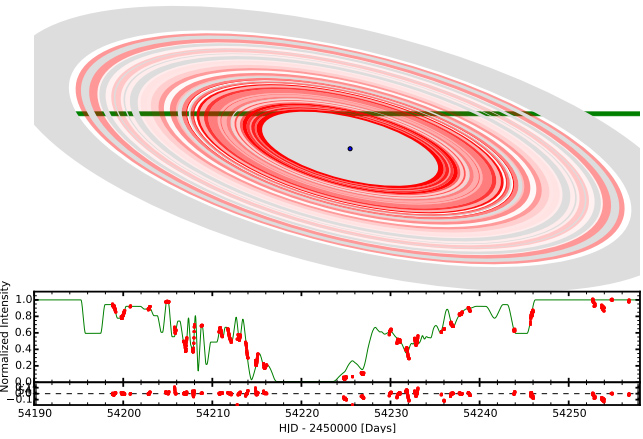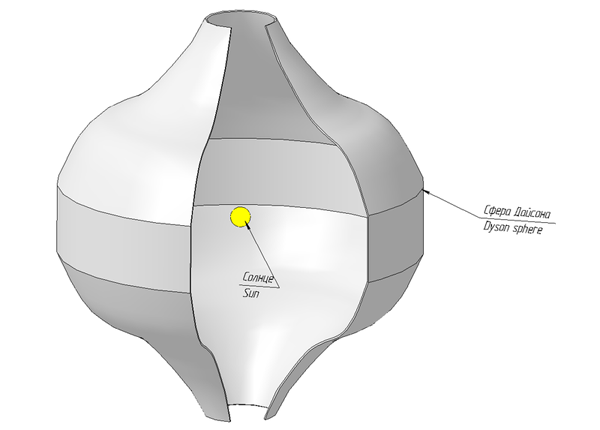WTF star: how aliens looked

A few weeks ago, there was news on the media about a possible discovery of a planet with megastructures - giant structures in its orbit. Those. implied the existence of an alien civilization many times superior to our development. Today I’ll tell you how they looked for aliens and what they found.

Star KIC 8462852 is located in a large star cluster in the constellation Cygnus, which is located about 1.5 thousand light years from the Sun. This cluster was chosen as the target for the NASA Kepler Space Telescope. The main objective of the telescope is photometry. He does not take beautiful photos, he just constantly looks at the stars in the cluster - and registers all the brightness fluctuations. (Now it’s not permanent, but this is a different story).
A change in the apparent brightness of a star can occur for several reasons: internal - when the brightness of a star changes from internal processes, such as the appearance of "sunspots"; and external reasons - when something passes between us and the star.
The second principle is based on the transit method of searching for exoplanets - planets in orbits of other stars. A planet passes between us and the star and the brightness of the star changes. Moreover, the fading of the star, which the planet can cause, gives a very characteristic picture of the brightness graph.
If the fluctuation of the brightness curve is repeated with a certain periodicity, then it is concluded that the fading of the star causes a planet that rotates in orbit and regularly blocks the light of the star from us. It is clear that such a method is far from absolute. Thus, it is easiest to find large planets that rotate close to the star. They are found - the so-called hot jupiters. The farther the planet is from its star, the less often it passes between us, and the smaller the planet, the weaker the deviation in the brightness of the star it gives. Therefore, it is more difficult to search for such planets, but they find something.
Equally important is the inclination of the planet’s orbit. The orbital plane of the exoplanet should lie on the line of our gaze. The slightest deviation - and goodbye discovery. For example, if we observe the Sun from the Earth, then for the next 100 years we will not be able to detect Venus in transit, which, it would seem, every three months should pass between us and the Sun. But the inclination of the orbits is slightly different, and that’s it. Transits of Venus took place in 2004 and 2012, and the next only in 2117.
The star KIC 8462852 attracted attention by the fact that once every 750 days it is blocked by something very large. The star was nicknamed WTF-star, due to the fact that the scientific article about the discovery was called Where's the flux? (Something like “Where does the light go?”), And because the find caused great surprise and bewilderment.

750 days is a rather large period, which means that something flies no closer than Mars. For example, at such a distance, Jupiter would cause a decrease in the brightness of the Sun by 4%, and KIC 8462852 dimmed by 15% in 2011 and by 22% in 2013. Moreover, the transit of 2012 was generally incredible - as if three giant planets in a row passed between us and the star.
Something similar had already happened when scientists discovered a planet that was recognized as a giant Saturn, with huge rings, but there the overlap of light reached 95%.

What can be near KIC 8462852? Scientists have suggested several hypotheses: a cloud of comets or asteroids or some other natural formation. I liked the idea that the telescope was able to consider an event similar to the one that formed the moon near the Earth, i.e. a consequence of the collision of two planets. Modeling shows that the formation of the moon was rapid, in the context of the age of the planets. “Seeing” is already an incredible rarity and luck for science. But unofficially, scientists have expressed a variant of alien megastructures.
Scientists have long been searching for the so-called " Dyson spheres"Hypothetical constructions of a planetary scale that could be erected by developed alien civilizations. As far back as the 60s, physicist Freeman Dyson suggested that civilizations of old stars would be forced to rebuild their system planets to surround their fading star with planetary matter. That is to build building materials from all the planets in order to build a sphere around the star in order to preserve all the radiated heat and light.

Theoretically, such objects can be seen by modern astronomy - this should be an object the scale of a star, which does not emit light in the visible range at all, but emits infrared rays, i.e. heat.
Dyson’s Spheres has been looking for a long time, but hasn’t found anything yet, and therefore grabbed KIC 8462852 as the last hope, next to which we can assume the start of construction, or the stripped-down version of the Niven’s ring . But science would not be science if the guess were not rechecked. The best and most affordable method is radio listening. It is believed that any sufficiently developed civilization will noticeably sound in the radio range. So far, only one planet is known that sounds abnormally loud in radio - Earth. To find others, SETI has been in operation for more than half a century- the search for extraterrestrial intelligence. While there is no specific goal, they listen to everything, and they heard nothing but a WOW signal. In the case of KIC 8462852, it is likely that for the first time the large radio “ears” of the project were aimed at a specific object in order to check the possibility of finding civilization there.
And nothing. Silence. More precisely, the noise is no different from natural. So civilization is not there. Or not already. Or the aliens completely abandoned the radio and switched to fiber and lasers. Those. they cannot be confirmed, even if they exist.
For additional cross-checking, we decided to look at the area in the infrared range. First, they raised the data of the NASA WISE project - an infrared telescope that made repeated inspections of the entire visible sphere of the sky to detect new planets of the solar system and distant galaxies. And nothing interesting was found in KIC 8462852.
Then they took a higher resolution telescope: NASA Spitzer and looked more closely. And again - the glow of the most ordinary star, without any abnormal deviations.

Observation in the infrared range and the absence of thermal glow invalidates the planetary collision hypothesis. When planets or asteroids collide, a large amount of stone dust is emitted, which, like the Dyson sphere, will block visible light and re-emit in the infrared range. Thus, only something large-scale and cold remains among the hypotheses - and this is a cloud of comets.
As a result, no matter how dreamers would like, astronomers were convinced by various methods of the absence of aliens from the WTF star. The most interesting thing in this story is a practical demonstration of the technical capabilities of terrestrial civilization - we already have the means to search for extraterrestrial civilizations hundreds of light-years away, and we independently check the data obtained. Now it’s a mistake, but if there is money, then the search will continue - the sky is big.
